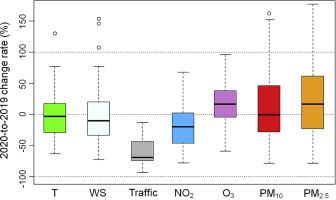Environmental Pollution ( IF 7.6 ) Pub Date : 2020-09-18 , DOI: 10.1016/j.envpol.2020.115682 Giovanni Gualtieri 1 , Lorenzo Brilli 1 , Federico Carotenuto 1 , Carolina Vagnoli 1 , Alessandro Zaldei 1 , Beniamino Gioli 1

|
Covid19-induced lockdown measures caused modifications in atmospheric pollutant and greenhouse gas emissions. Urban road traffic was the most impacted, with 48‒60% average reduction in Italy. This offered an unprecedented opportunity to assess how a prolonged (∼2 months) and remarkable abatement of traffic emissions impacted on urban air quality. Six out of the eight most populated cities in Italy with different climatic conditions were analysed: Milan, Bologna, Florence, Rome, Naples, and Palermo. The selected scenario (24/02/2020‒30/04/2020) was compared to a meteorologically comparable scenario in 2019 (25/02/2019–02/05/2019). NO2, O3, PM2.5 and PM10 observations from 58 air quality and meteorological stations were used, while traffic mobility was derived from municipality-scale big data.
NO2 levels remarkably dropped over all urban areas (from ‒24.9% in Milan to ‒59.1% in Naples), to an extent roughly proportional but lower than traffic reduction. Conversely, O3 concentrations remained unchanged or even increased (up to 13.7% in Palermo and 14.7% in Rome), likely because of the reduced O3 titration triggered by lower NO emissions from vehicles, and lower NOx emissions over typical VOCs-limited environments such as urban areas, not compensated by comparable VOCs emissions reductions. PM10 exhibited reductions up to 31.5% (Palermo) and increases up to 7.3% (Naples), while PM2.5 showed reductions of ∼13–17% counterbalanced by increases up to ∼9%. Higher household heating usage (+16–19% in March), also driven by colder weather conditions than 2019 (‒0.2 to ‒0.8 °C) may partly explain primary PM emissions increase, while an increase in agriculture activities may account for the NH3 emissions increase leading to secondary aerosol formation. This study confirmed the complex nature of atmospheric pollution even when a major emission source is clearly isolated and controlled, and the need for consistent decarbonisation efforts across all emission sectors to really improve air quality and public health.
Main finding A 2-month urban traffic ban extended to the whole Italy only significantly reduced NO2 levels, while O3, PM2.5 and PM10 concentrations were affected to a minor extent.
中文翻译:

量化道路交通对城市地区空气质量的影响:意大利因 Covid19 引发的封锁分析
Covid19 引发的封锁措施导致大气污染物和温室气体排放发生变化。城市道路交通受到的影响最大,意大利平均减少了 48-60%。这为评估长期(约 2 个月)和显着减少交通排放如何影响城市空气质量提供了前所未有的机会。分析了意大利八个气候条件不同的人口最多的城市中的六个:米兰、博洛尼亚、佛罗伦萨、罗马、那不勒斯和巴勒莫。将所选情景(24/02/2020-30/04/2020)与 2019 年的气象可比情景(25/02/2019–02/05/2019)进行了比较。NO 2、O 3、PM 2.5和 PM 10使用了来自 58 个空气质量和气象站的观测数据,而交通流动性则来自市级大数据。
NO 2水平在所有城市地区都显着下降(从米兰的 ‒24.9% 到那不勒斯的 ‒59.1%),下降幅度大致成正比,但低于交通减少量。相反,O 3浓度保持不变甚至增加(在巴勒莫高达 13.7%,在罗马高达 14.7%),这可能是因为车辆的 NO 排放量较低以及 NO x排放量低于典型的 VOC 限制导致的 O 3滴定减少城市地区等环境,未通过可比的 VOC 排放量减少进行补偿。PM 10减少了 31.5%(巴勒莫),增加了 7.3%(那不勒斯),而 PM 2.5显示减少了~13-17%,增加了~9%。较高的家庭供暖使用量(3 月增加 16-19%),也是由于比 2019 年更冷的天气条件(-0.2 至 ‒0.8 °C),可能部分解释了初级 PM 排放量的增加,而农业活动的增加可能是 NH 的原因3排放增加导致二次气溶胶形成。这项研究证实了大气污染的复杂性,即使主要排放源被明确隔离和控制,也需要在所有排放部门进行持续的脱碳努力,以真正改善空气质量和公众健康。
主要发现 为期 2 个月的城市交通禁令扩展到整个意大利,仅显着降低了 NO 2水平,而 O 3、PM 2.5和 PM 10浓度受到轻微影响。











































 京公网安备 11010802027423号
京公网安备 11010802027423号